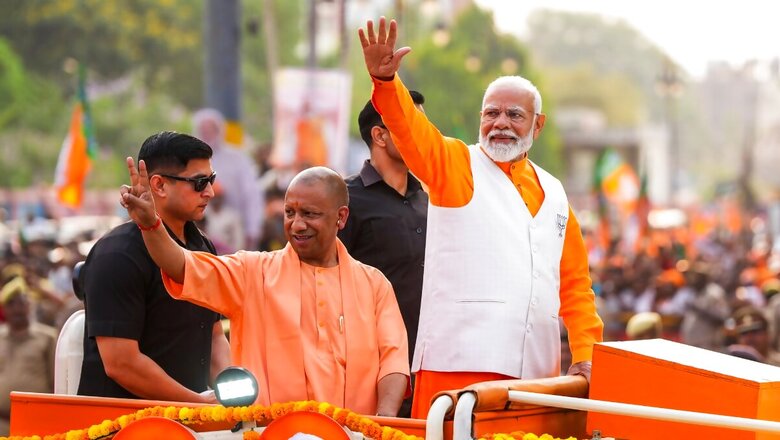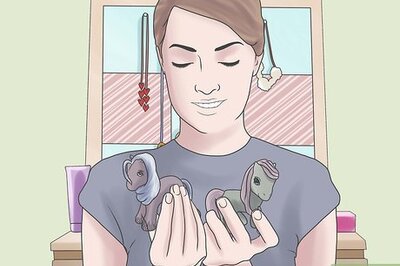
views
The last few years have been momentous in the history of Kashi. Not only has the city given India one of its most popular and powerful prime ministers ever, but it has also witnessed rapid development that only an MP of Narendra Modi’s towering stature could have ushered in. PM Modi laid the foundation stone of the Trade Facilitation Centre and Crafts Museum way back in 2017, for the benefit of many weavers, craftsmen and artisans of Varanasi and nearby areas.
He had once remarked that India cannot become a Vishwa Guru without the development of Kashi. Development of Kashi is in turn, incomplete without bettering the lives of weavers. In the last 10 years, Mirzapur and Bhadohi regions within Varanasi have become mega carpet weaving clusters. Handicrafts of Kashi are widespread in the form of cottage industries, with Banarasi silk sarees, the textile and carpet industries being some of the prominent ones. Lakhs of handloom weavers are directly or indirectly related with these industries. Measures taken for the betterment of weavers and artisans have gone a long way in enhancing their incomes.
For the retention of the next generation of weavers, a carpet engineering program is being run at IICT Bhadohi. 75 per cent fees of the students belonging to poor families of weavers is being taken care of by the Modi government. There is a provision for margin money of Rs 10,000 in the MUDRA scheme for weavers. Mega carpet clusters in Mirzapur and Bhadohi are being given modern looms. Also, workers and craftsmen are being imparted skills under skill development programs. To realise this goal, a BTech program in the carpet technology area, is being run in IICT Bhadohi. India currently occupies over 35 per cent share of the world’s carpet market. PM Modi has set a target to own over 50 per cent of the world’s carpet market.
Across India, after PM Modi took up the cause of promoting Khadi, sales have been on an upswing. In Varanasi too, Khadi institutions and workers are being encouraged, with credit linked capital subsidy (CLCS). Khadi as a concept is now a mushrooming business proposition in Kashi. Under Kaushal Vikas Yojana, thousands of youth are being skilled and empowered. The commencement of expansion of Diesel Locomotive Works also started, thanks to PM Modi.
Speaking of welfarism, under Awas Yojana (Urban), Varanasi has seen 24,515 houses being built, with 47 per cent of the beneficiaries belonging to the SC, ST and minority communities. Jal Jeevan Mission in Kashi has seen 3.2 lakh households getting tap water connections. Varanasi has also seen “ODF-Plus” model verified villages, unleashing a new revolution in terms of sanitation and cleanliness. Under PM Modi’s flagship Swachh Bharat Mission, over 3.47 lakh toilets were built. 11.6 lakh Ayushman cards were created, with over 13 lakh ABHA IDs generated, for the people of Kashi alone in the last 10 years. PM Matru Vandana Yojana in Varanasi has 17000 beneficiaries and Janani Suraksha Yojana another 71000 beneficiaries.
Beyond PM Modi’s welfarism, Kashi has emerged as Purvanchal’s medical nucleus. GSDP of Varanasi stands at Rs 18,727.23 crore. Investment worth Rs 11,500 crore has been made in the tourism sector in the last few years. Additionally, infrastructure projects in Varanasi amounting to over Rs 13,000 crore and development projects worth Rs 45,000 crore have also been gifted to Kashi by PM Modi. An LPG bottling plant by HPCL, NIFT Varanasi and Banas Kashi Sankul milk processing unit in UPSIDA Agro park at Karkhiyaon will boost the income of more than 6 lakh people and create huge employment opportunities. The first phase of Sigra Stadium and district rifle shooting range to boost the sports industry are also welcome moves. Kashi Vishwanath Corridor is the crown jewel of Varanasi, with more than 13 crore people visiting the city in the last 18 months alone. Tourist footfall in Kashi is 8 times higher than the average annual footfall of Goa.
Be it launching electric catamaran vessels to enhance the tourism experience in the Ganges with the use of green energy, or upgrading the Lucknow-Agra Expressway, which aims to reduce travel time between Agra and Lucknow by 4 hours, or the Varanasi-New Delhi Vande Bharat train, Modi’s focus on Uttar Pradesh has yielded rich dividends in terms of growth and livelihood for the commoners. In Varanasi alone, PM Mudra Yojana saw over Rs 1144 crore being distributed to over 1.83 lakh beneficiaries. 81000 farmers in the Kashi region got Kisan credit cards and over 1.2 lakh farmers benefited from PM Kisan Samman Nidhi Yojana. PM Jeevan Jyoti Bima Yojana helped 3.25 lakh beneficiaries from Kashi, while 11.44 lakh Jan Dhan Accounts were opened.
Construction of 680 kms of roads in Varanasi and PM Gramin Sadak Yojana, spearheading construction of an additional 227 kms of roads, have improved connectivity. Varanasi Ring Road Phase 1 has been constructed at a cost of just Rs 759 crore. Additionally, 15 cargo boats have started operating, electrification of 41,164 new connections under the Saubhagya Yojana has been completed, 14,212 women have received training via “Ajeevika Sakhi”, 12,650 women in Kashi have undergone advanced agricultural training, and gainful employment has been provided under the National Rural Livelihood Mission to 44 lakh women in Uttar Pradesh, including Varanasi. These achievements represent key milestones of the Varanasi growth model. Over 4600 self-help groups (SHGs) connected to self-employment are functional in Varanasi.
Speaking of cultural renaissance, PM Modi launched the Kashi Tamil Sangamam to unite Tamil and Kashi culturally. Over 2500 delegates came from Tamil Nadu in 2019.
In the last 10 years, PM Modi has visited Varanasi over 43 times. Modi walks the talk and loves mingling with people, with his ears close to the ground. He is not an armchair politician, like others from the Opposition camp. Compare Modi’s excellent ground-connect with, say, that of Sonia Gandhi, who did not visit Raebareli even once in the last 5 years and her son Rahul Gandhi, who did not visit Wayanad even 4 times in the last 5 years.
Modi’s tryst with Varanasi has only strengthened over the years. Taking forward the progressive journey of “Vikaswaad” in Varanasi, Prime Minister Narendra Modi on July 15, 2021, inaugurated and laid the foundation stones of multiple development projects worth more than Rs 1500 crore at the IIT-BHU ground. He also inaugurated the International Cooperation and Convention Centre ‘Rudrakash’, which was constructed with Japanese assistance later. Various public projects and works, including a 100-bed MCH wing in BHU, multi-level parking at Godauliya, Ro-Ro vessels for tourism development on River Ganga and a three-lane flyover bridge on the Varanasi-Ghazipur highway were the defining projects flagged off by the prime minister. Central Institute of Petrochemical Engineering and Technology (CIPET), 143 ongoing rural projects under Jal Jeevan Mission and a mango and vegetable integrated packhouse in Karkhiyaon, are alone worth over Rs 839 crore.
On a visit to Varanasi on the occasion of Good Governance Day, in 2014, PM Modi, without any hesitation, picked up a broom and participated in a cleanliness drive at Jagannath Gali near Assi Ghat. Further, speaking on the occasion, the PM described the land of Kashi as one which gave us “shiksha ki sanskriti” (a culture of education). And indeed, within barely eight years, Varanasi today, which has transformed into a thriving medical hub of the Purvanchal region, is known as the unique seat of holistic learning, with a humanist vision. In 2014, when PM Modi was elected as the MP of Varanasi, he remarked, “There’s a lot of work that God has put me on this Earth for. A lot of it is dirty work, but I’m up to the task.”
Since then, in the last ten years, Varanasi has undergone a transformative revolution, boasting world-class infrastructure, express trains, underground cabling, waste treatment plants, a cultural convention centre, modern traffic control, a multimodal terminal, and a container depot for perishables. At the heart of this revitalisation stands the Kashi Vishwanath Dham, a testament to Kashi’s vibrancy.
PM Narendra Modi laid the foundation stone of the Ring Road and Phase-1 was completed in November 2018 in record time, making traffic movement across the city much easier and helping decongestion of roads. Varanasi has a very busy airport due to the movement of pilgrims and tourists in and out of the city. The over 17-kilometre-long airport road developed under the aegis of PM Modi is called the Gateway of Varanasi today.
PM Narendra Modi laid the foundation of two dedicated cancer hospitals in Varanasi, a few years back. Also, IMS BHU was accorded AIIMS-like status, which will further improve health facilities in the hospital. Kashi is called the city of Mahadev, as in Lord Shiva and the development of Kashi Vishwanath Corridor is a boon to lakhs of devotees of Shiva, who are making use of the direct link developed between the temple and Ganga ghat.
Kashi, a vibrant and bustling city, generates substantial waste and sewage. Prime Minister Modi recognized that Kashi’s beautification would remain incomplete without addressing the persistent sewage problem, a long-standing issue that had been neglected by previous administrations. In 2018, a state-of-the-art 140 million litre per day (MLD) sewage treatment plant (STP) was established in Dinapur. This initiative has significantly reduced river pollution and enabled the city to efficiently manage its large waste output.
Kashi is experiencing unprecedented development, and its residents are directly benefiting from Prime Minister Modi’s dedicated service as their MP. At the request of local small business owners, a “cheque bounce” law was repealed, offering relief to scores of traders and proprietors. Furthermore, the ‘Jan Sampark’ office of PM Modi in Kashi is dedicated to the service of common people in the city and has done exemplary work when floods hit the city in 2020 or when the second Covid wave struck with impunity.
Ten years ago, PM Narendra Modi selected Jayapur, a small village in Varanasi located 7 km from the Rajatalab Railway Station, for the ‘Saansad Adarsh Gram Yojana’. He stated that this yojana wasn’t about MPs taking guardianship of villages, but rather about villagers taking MPs under their wing. “Can we decide that we will not allow Jayapur to become dirty; can we ensure children wash hands before eating”, the prime minister had asked the large gathering at Jayapur, asserting that these things did not require government intervention. He said such positive social energy can help create a model village. Days after he met and addressed the people of Jayapur, they reciprocated, by turning the birth of a girl child into a festive occasion and planting trees. 10 years hence, Jayapur has seen a steep decline in female infanticide, infant and maternal mortality rates and has seen a huge improvement in almost all social indices, showcasing how one man made such a huge impact on the lives of millions.
The moment it became clear that the second wave of Covid had hit India, the PM sent his emissary, a long-time aide, AK Sharma to Varanasi with instructions to take proactive measures and make sure the damage was controlled. Sharma landed in Varanasi on April 13, 2021, and immediately set in motion a 24/7 Command and Control room. With 20 dedicated phone lines and round-the-clock manpower, the “Kashi Covid Response Centre” became the hub of coordination between various arms of administration, as also interface with the people, for a seamless management of the situation. Two oxygen plants, hundreds of oxygen cylinders and concentrators were ordered and a DRDO Covid hospital was also set up, to tide over the crisis. The positivity rate of the district came down from a high of over 30 per cent to less than 13 per cent in a matter of days.
The administration ramped up the RT-PCR testing capacity of Kashi city from 5000 to 12000 per day, ensuring that the results were available within 24 hours. Sharma arranged for two automatic RNA extractor machines from Assocham, enabling quicker testing. Of the four Oxygen plants in Varanasi supplying 12000 LPM Oxygen, one each was imported from the United States and Israel, while the other two were procured from Maharashtra and Gujarat, respectively. Varanasi also had the highest supply of Remdesivir injections, at about 700 vials a day. During the second wave in April and May 2021, the vaccination rate in Kashi exceeded 9000 per day, one of the highest for any city in Uttar Pradesh.
Another far-sighted step taken on the instructions of PM Modi was to make sure the rural areas were protected. The administration distributed 70,000 medical kits to contain the pandemic in the rural hinterland of Varanasi and the healthcare staff at the primary and secondary dispensaries were trained on a war footing on the use of Oxymeters and other testing paraphernalia. The result was heartening with distress calls from rural areas coming down from a peak of 800 per day, to about 100 at the Command and Control Centre, within days. Amid worries of a possible third wave of Covid in 2022, which could have impacted children more, the inauguration of the MCH unit at Banaras Hindu University (BHU) hospital, in Varanasi, by the PM showcased how health has always been a top-of-the-mind agenda for the Modi government. Considered to be the AIIMS of Purvanchal (East UP), adjoining Bihar and even Nepal, the Sir Sunderlal Hospital in BHU campus that got the MCH wing, has seen the number of beds rise from 1500 to over 2700 in just ten years.
PM Modi’s affection for the mystical city of Kashi is well known. In his own words, to the people of Kashi, Modi said, “Kashi owns me, I am imprisoned in its love.” Be it unveiling the plaque of the Inter-University Centre, launching the campus connect WiFi of BHU, or launching the Madan Mohan Malviya National Mission for teachers and the National Livelihood Mission for women, Narendra Modi has done pathbreaking work, both as the PM and as the MP of Kashi. Turning ‘Swachh Bharat Abhiyan’ into a ‘Jan Andolan’ has been a hugely rewarding journey for Modi and of course, for the nation. It would be apt to recall a powerful quote by none other than PM Modi, which captures the essence of his famous Varanasi model – “I make changes not for people to notice; rather because it is my mission.” And truly enough, the transformation of Varanasi in the last ten years has been nothing short of extraordinary.
“When the world is in crisis, we must pledge – a pledge which is bigger than the crisis itself. We must strive to make the 21st century, India’s century. And the path to do that is self-reliance”— this powerful quote by none other than Prime Minister Narendra Modi sums up the ethos of the “Varanasi Model” in more ways than one. Indeed, the Varanasi model blends the Puritan with the modern, innovation with spirituality and fast-paced progress with equity, reflective of an aspirational India, in the true sense of the term.
Sanju Verma is an Economist, National Spokesperson of the BJP and the Bestselling Author of ‘The Modi Gambit’. Views expressed in the above piece are personal and solely that of the author. They do not necessarily reflect News18’s views.















Comments
0 comment